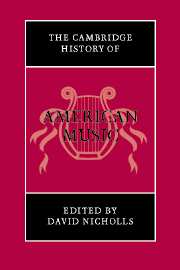Book contents
- Frontmatter
- PART ONE
- 1 American Indian musics, past and present
- 2 Music in America: an overview (part 1)
- 3 Secular music to 1800
- 4 Sacred music to 1800
- 5 African American music to 1900
- 6 Immigrant, folk, and regional musics in the nineteenth century
- 7 Nineteenth-century popular music
- 8 Art music from 1800 to 1860
- 9 Art music from 1860 to 1920
- PART TWO
- Bibliography and references
- Index
- References
3 - Secular music to 1800
from PART ONE
Published online by Cambridge University Press: 28 March 2008
- Frontmatter
- PART ONE
- 1 American Indian musics, past and present
- 2 Music in America: an overview (part 1)
- 3 Secular music to 1800
- 4 Sacred music to 1800
- 5 African American music to 1900
- 6 Immigrant, folk, and regional musics in the nineteenth century
- 7 Nineteenth-century popular music
- 8 Art music from 1800 to 1860
- 9 Art music from 1860 to 1920
- PART TWO
- Bibliography and references
- Index
- References
Summary
Throughout the world, music is used by the powerful to advance their personal or political agendas, by governments to achieve national objectives, by performers and tradesmen to earn a living, and by the people for entertainment and individual goals. Thus, the music played and heard in colonial America was defined by the distinct national cultures that held political power and whose people populated its land.
The first colonists arrived from and perpetuated a world in which the arts were divided. On one side were the cultivated arts of music and dance, enriched by centuries of patronage from the court and nobility. Settlers with ample means purchased instruments and music, hired professional instructors, and enjoyed playing or listening to new compositions of British and European artists. They performed the latest dances learned from their teachers or from books ordered from London, Paris, or Madrid, depending on trade connections at the time. In colonial societies that were anxious to appear as refined as those in the mother countries, capability in, or consumption of, the arts was a sign of gentility, affluence, and influence; it gave evidence of sufficient means to obtain appreciation, training, and leisure to practice necessary skills.
On the other side was the music of the people. The laboring, farming, and servant classes had little access to cultivated music. They did not understand it and they did not need it. Their long-lived ballads and dancing tunes were seldom consciously learned but rather absorbed from frequent hearing. They were an integral part of their community bond and identification.
- Type
- Chapter
- Information
- The Cambridge History of American Music , pp. 49 - 77Publisher: Cambridge University PressPrint publication year: 1998

